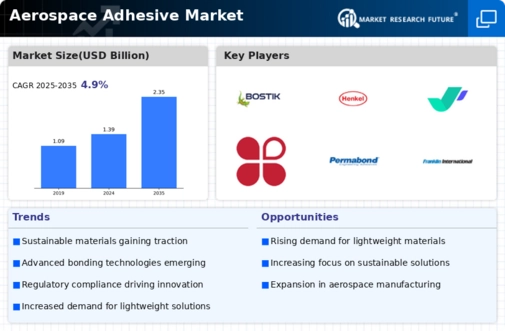Market Trends and Projections
Expansion of the Aerospace Industry
The expansion of the aerospace industry is a pivotal driver for the Global Aerospace Adhesive Market Industry. As global air travel continues to grow, the demand for new aircraft and maintenance of existing fleets is on the rise. This growth is reflected in the increasing production rates of commercial aircraft, which subsequently boosts the need for high-performance adhesives. The market is projected to grow at a CAGR of 4.89% from 2025 to 2035, indicating a robust future for aerospace adhesives. This expansion not only enhances the market landscape but also encourages innovation in adhesive technologies tailored for aerospace applications.
Rising Focus on Sustainable Practices
The Global Aerospace Adhesive Market Industry is witnessing a rising focus on sustainable practices within the aerospace sector. Manufacturers are increasingly adopting eco-friendly adhesives that minimize environmental impact while maintaining performance standards. This shift is driven by consumer demand for greener alternatives and regulatory pressures to reduce carbon footprints. The integration of sustainable materials in adhesive formulations is becoming a key differentiator for companies in the aerospace market. As sustainability becomes a priority, the Global Aerospace Adhesive Market Industry is likely to see a significant transformation, with an emphasis on developing adhesives that align with environmental goals.
Growing Demand for Lightweight Materials
The Global Aerospace Adhesive Market Industry is experiencing a surge in demand for lightweight materials, driven by the aerospace sector's ongoing efforts to enhance fuel efficiency and reduce emissions. Adhesives play a crucial role in bonding lightweight composites and metals, which are increasingly utilized in aircraft manufacturing. As airlines and manufacturers prioritize sustainability, the market for aerospace adhesives is projected to reach 1.39 USD Billion in 2024. This trend aligns with the industry's shift towards advanced materials that not only improve performance but also contribute to lower operational costs, thereby fostering growth in the Global Aerospace Adhesive Market Industry.
Regulatory Compliance and Safety Standards
The Global Aerospace Adhesive Market Industry is significantly impacted by stringent regulatory compliance and safety standards imposed by aviation authorities worldwide. These regulations necessitate the use of high-quality adhesives that meet specific performance criteria, ensuring the safety and reliability of aircraft. Manufacturers are compelled to invest in advanced adhesive solutions that comply with these regulations, driving market growth. The increasing focus on safety in aviation is likely to propel the demand for aerospace adhesives, as companies strive to adhere to these standards. This trend underscores the critical role of compliance in shaping the Global Aerospace Adhesive Market Industry.
Technological Advancements in Adhesive Formulations
Innovations in adhesive formulations are significantly influencing the Global Aerospace Adhesive Market Industry. The development of high-performance adhesives that can withstand extreme temperatures and environmental conditions is becoming increasingly vital. For instance, advancements in epoxy and polyurethane adhesives are enabling manufacturers to achieve stronger bonds while maintaining flexibility. These innovations are likely to enhance the durability and longevity of aerospace components, which is essential for safety and reliability. As a result, the market is expected to grow, with projections indicating a rise to 2.35 USD Billion by 2035, reflecting the importance of cutting-edge adhesive technologies in the aerospace sector.









